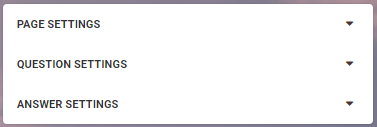You will find your page settings on the right hand slider within your questionnaire builder. It will consist of some general settings that are related to the page types. In this articles we will explain the different options that you can encounter within the page settings sections.

Page name
Setting Type: Textbox
Default Setting: Previously entered page name
Functionality: Shows the name of the page that you entered when creating it. You are not able to edit this, since it is used as a reference in other parts of the system.
Relevant for pages: Grouping Page, Information Page, End Page, General Page, Single Question Page, Matrix Page, Input Form Page, Root Cause Page, KPI Page, Checklist Page
Note: This is fixed and automatically generated for Start, End, Completed and Time Elapsed pages.
Active (show to respondent)
Setting type: Switch
Default setting: On
Functionality: Turning this switch on shows the current page to the respondent. Turning it off hides it from the respondent’s view.: Grouping Page, Information Page, Start Page, End Page, General Page, Single Question Page, Matrix Page, Input Form Page, Root Cause Page, KPI Page, Checklist Page
Note: This setting is always turned ON for Completed Pages and Time Elapsed Pages. This functionality cannot be turned off for these pages.
Show Progress Bar
Setting Type: Switch
Default setting: On
Functionality: Turning this switch on shows the progress bar to the respondent and lets him see how far along the questionnaire he is. Turning it off hides it from the respondent’s view.
Relevant for pages: Information Page, Start Page, End Page General Page, all Question Pages. Not available on Grouping pages.
Show Next Page
Setting Type: Switch
Default setting: On
Functionality: Turning this switch on shows the “next” button to the respondent. Turning this switch off hides the next button from the respondent.
Relevant for pages: Information Page, Start Page, General Page, Single question Page, matrix Page, Input form Page, Root Cause Page, KPI Page, Checklist Page
Note: If you remove this button, you take away the possibility for the respondent to actively navigate forward in the questionnaire. Make sure you have turned on “auto proceed” with a logical routing when disabling this setting.
Show Previous Page:
Setting Type: Switch
Default Setting: On
Functionality: Turning this switch on shows the “previous” button to the respondent. Turning this switch off hides the “previous” button from the client.
Relevant for pages: Information page, End Page, General Page, Single question Page, matrix Page, Input form Page, Root Cause Page, KPI Page, Checklist Page
Note: If you remove this button, the respondent will not be able to navigate back in the questionnaire to review or change answers.
Error message
Setting Type: Textbox
Default Setting: “Oops, something went wrong. You might have forgotten an answer! Can you please check and try again?”
Functionality: This is an error message that will pop up when an error occurs. Only one error message per page can be set up. The default setting is a placeholder, but you can edit this to enter your own text.
Relevant for pages: General Page, Single question Page, matrix Page, Input form Page, Root Cause Page, KPI Page, Checklist Page
Note: Take care you present the error message in a nice and understandable way to the respondent. If you add specific conditions to a page, be sure to explain them in the error message as well.
Routing
Setting Type: Dropdown
Default Setting: Next Page
Functionality: This will decide the routing for the next page.
Relevant for pages: Information Page, Start Page, General Page, Single Question Page, Matrix Page, Input Form Page, Root Cause Page, KPI Page, Checklist Page.
Note: If there are multiple routing rules applied to a page, the order of hierarchy defines which routing is executed:
1) Dynamic Rule Engine 2) Routing Answer setting 3) Routing Page Setting 4) Default Routing.
Auto-Proceed
Setting Type: Switch
Default Setting: Off
Functionality: When the respondent provides an answer, the page will automatically jump to the next page
Relevant for: Single Question Page (not on comment box), Matrix Page, Root Cause Page, KPI Page
Note: Routing will take place according to routing hierarchy. Take extra care when selecting minimum/maximum amount of options to be checked and when using the 'create comment box' option.
Switch between single-response and multi-response
Setting Type: Switch
Default setting: Depending on choice of question page made in the slider
Functionality: Toggling this will switch between single response and multi response
Relevant for page: Single question page (only for single), Matrix Page
Note: the checkboxes will change from circles in case of single response to checkboxes and vice versa in case of multi response. This change also impacts the way your data is stored in the data garden (multiple columns for multi response vs one column for single response)
Show HTML/CSS Editor Tab
Setting Type: Switch
Default setting: Off
Functionality: This function opens an additional tab to the editor view of the concerned page that provides you with an option to enter CSS/HTML code which renders into a webpage for the respondent
Relevant for: Information page, Start page, End page and Time Elapsed page.
Coloring
Setting Type: Switch
Default setting: On (with default settings)
Functionality: This function lets you set the colors of the values within the scale as shown to the respondent
Relevant for: KPI Pages
Show attach media
Setting Type: Switch
Default setting: On
Functionality: Checking this option offers the respondent to add a photo to every question as proof of as an illustration of the answer (s)he just provided.
Relevant for: Checklist Pages
Show comment box
Setting Type: Switch
Default setting: On
Functionality: Checking this option creates a comment box on every subpage for the respondent to provide extra information
Relevant for: Checklist Pages
